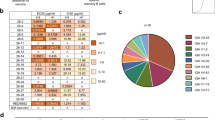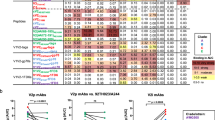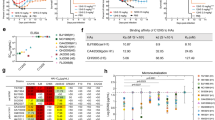Abstract
New modes of humoral recognition have been identified by studies of antibodies that neutralize human immunodeficiency virus type 1 and influenza A viruses. Understanding how such modes of antibody-antigen recognition can occur in the context of sophisticated mechanisms of humoral evasion has implications for the development of effective vaccines. Here we describe eight modes of antibody recognition first observed with human immunodeficiency virus type 1. Similarities to four of these modes have been identified with antibodies to a conserved 'stem' epitope on influenza A viruses. We outline how each of these different modes of antibody recognition is particularly suited to overcoming a specific viral evasion tactic and assess potential routes of re-elicitation in vaccine settings.
This is a preview of subscription content, access via your institution
Access options
Subscribe to this journal
Receive 12 print issues and online access
$209.00 per year
only $17.42 per issue
Buy this article
- Purchase on Springer Link
- Instant access to full article PDF
Prices may be subject to local taxes which are calculated during checkout



Similar content being viewed by others
References
Wei, X. et al. Antibody neutralization and escape by HIV-1. Nature 422, 307–312 (2003).
Richman, D.D., Wrin, T., Little, S.J. & Petropoulos, C.J. Rapid evolution of the neutralizing antibody response to HIV type 1 infection. Proc. Natl. Acad. Sci. USA 100, 4144–4149 (2003).
Weiss, R.A. et al. Neutralization of human T-lymphotropic virus type III by sera of AIDS and AIDS-risk patients. Nature 316, 69–72 (1985).
Li, Y. et al. Broad HIV-1 neutralization mediated by CD4-binding site antibodies. Nat. Med. 13, 1032–1034 (2007).
Dhillon, A.K. et al. Dissecting the neutralizing antibody specificities of broadly neutralizing sera from human immunodeficiency virus type 1-infected donors. J. Virol. 81, 6548–6562 (2007).
Doria-Rose, N.A. et al. Frequency and phenotype of human immunodeficiency virus envelope-specific B cells from patients with broadly cross-neutralizing antibodies. J. Virol. 83, 188–199 (2009).
Sather, D.N. et al. Factors associated with the development of cross-reactive neutralizing antibodies during human immunodeficiency virus type 1 infection. J. Virol. 83, 757–769 (2009).
Binley, J.M. et al. Comprehensive cross-clade neutralization analysis of a panel of anti-human immunodeficiency virus type 1 monoclonal antibodies. J. Virol. 78, 13232–13252 (2004).
Wyatt, R. et al. The antigenic structure of the HIV gp120 envelope glycoprotein. Nature 393, 705–711 (1998).
Starcich, B.R. et al. Identification and characterization of conserved and variable regions in the envelope gene of HTLV-III/LAV, the retrovirus of AIDS. Cell 45, 637–648 (1986).
Kwong, P.D. et al. HIV-1 evades antibody-mediated neutralization through conformational masking of receptor-binding sites. Nature 420, 678–682 (2002).
Labrijn, A.F. et al. Access of antibody molecules to the conserved coreceptor binding site on glycoprotein gp120 is sterically restricted on primary human immunodeficiency virus type 1. J. Virol. 77, 10557–10565 (2003).
Calarese, D.A. et al. Antibody domain exchange is an immunological solution to carbohydrate cluster recognition. Science 300, 2065–2071 (2003).
Geijtenbeek, T.B. et al. DC-SIGN, a dendritic cell-specific HIV-1-binding protein that enhances trans-infection of T cells. Cell 100, 587–597 (2000).
Korber, B. et al. Evolutionary and immunological implications of contemporary HIV-1 variation. Br. Med. Bull. 58, 19–42 (2001).
Stanfield, R.L., Gorny, M.K., Williams, C., Zolla-Pazner, S. & Wilson, I.A. Structural rationale for the broad neutralization of HIV-1 by human monoclonal antibody 447–52D. Structure 12, 193–204 (2004).
Bell, C.H. et al. Structure of antibody F425–B4e8 in complex with a V3 peptide reveals a new binding mode for HIV-1 neutralization. J. Mol. Biol. 375, 969–978 (2008).
Pan, C., Lu, H., Qi, Z. & Jiang, S. Synergistic efficacy of combination of enfuvirtide and sifuvirtide, the first- and next-generation HIV-fusion inhibitors. AIDS 23, 639–641 (2009).
Colman, P.M. New antivirals and drug resistance. Annu. Rev. Biochem. published online, doi:10.1146/annurev.biochem.78.082207.084029 (2 March 2009).
Luftig, M.A. et al. Structural basis for HIV-1 neutralization by a gp41 fusion intermediate-directed antibody. Nat. Struct. Mol. Biol. 13, 740–747 (2006).
Wu, L. et al. CD4-induced interaction of primary HIV-1 gp120 glycoproteins with the chemokine receptor CCR-5. Nature 384, 179–183 (1996).
Decker, J.M. et al. Antigenic conservation and immunogenicity of the HIV coreceptor binding site. J. Exp. Med. 201, 1407–1419 (2005).
Huang, C.C. et al. Structural basis of tyrosine sulfation and VH-gene usage in antibodies that recognize the HIV type 1 coreceptor-binding site on gp120. Proc. Natl. Acad. Sci. USA 101, 2706–2711 (2004).
Farzan, M. et al. Tyrosine sulfation of the amino terminus of CCR5 facilitates HIV-1 entry. Cell 96, 667–676 (1999).
Choe, H. et al. Tyrosine sulfation of human antibodies contributes to recognition of the CCR5 binding region of HIV-1 gp120. Cell 114, 161–170 (2003).
Huang, C.C. et al. Structures of the CCR5 N terminus and of a tyrosine-sulfated antibody with HIV-1 gp120 and CD4. Science 317, 1930–1934 (2007).
Muster, T. et al. Cross-neutralizing activity against divergent human immunodeficiency virus type 1 isolates induced by the gp41 sequence ELDKWAS. J. Virol. 68, 4031–4034 (1994).
Muster, T. et al. A conserved neutralizing epitope on gp41 of human immunodeficiency virus type 1. J. Virol. 67, 6642–6647 (1993).
Ofek, G. et al. Structure and mechanistic analysis of the anti-human immunodeficiency virus type 1 antibody 2F5 in complex with its gp41 epitope. J. Virol. 78, 10724–10737 (2004).
Alam, S.M. et al. The role of antibody polyspecificity and lipid reactivity in binding of broadly neutralizing anti-HIV-1 envelope human monoclonal antibodies 2F5 and 4E10 to glycoprotein 41 membrane proximal envelope epitopes. J. Immunol. 178, 4424–4435 (2007).
Gorny, M.K. et al. Identification of a new quaternary neutralizing epitope on human immunodeficiency virus type 1 virus particles. J. Virol. 79, 5232–5237 (2005).
Chan-Hui, P.-Y. et al. Isolation of HIV-neutralizing human monoclonal antibodies from memory B cell repertoire using short term culture and high-throughput binding and neutralization screens. Keystone Symposium on Prevention of HIV/AIDS, poster 119 (Keystone, Colorado, 2009).
Zhou, T. et al. Structural definition of a conserved neutralization epitope on HIV-1 gp120. Nature 445, 732–737 (2007).
Rossmann, M.G. The canyon hypothesis. Viral Immunol. 2, 143–161 (1989).
Smith, T.J., Chase, E.S., Schmidt, T.J., Olson, N.H. & Baker, T.S. Neutralizing antibody to human rhinovirus 14 penetrates the receptor-binding canyon. Nature 383, 350–354 (1996).
Collis, A.V., Brouwer, A.P. & Martin, A.C. Analysis of the antigen combining site: correlations between length and sequence composition of the hypervariable loops and the nature of the antigen. J. Mol. Biol. 325, 337–354 (2003).
Saphire, E.O. et al. Crystal structure of a neutralizing human IGG against HIV-1: a template for vaccine design. Science 293, 1155–1159 (2001).
De Genst, E., Saerens, D., Muyldermans, S. & Conrath, K. Antibody repertoire development in camelids. Dev. Comp. Immunol. 30, 187–198 (2006).
Dooley, H. & Flajnik, M.F. Antibody repertoire development in cartilaginous fish. Dev. Comp. Immunol. 30, 43–56 (2006).
Okuno, Y., Isegawa, Y., Sasao, F. & Ueda, S. A common neutralizing epitope conserved between the hemagglutinins of influenza A virus H1 and H2 strains. J. Virol. 67, 2552–2558 (1993).
Kashyap, A.K. et al. Combinatorial antibody libraries from survivors of the Turkish H5N1 avian influenza outbreak reveal virus neutralization strategies. Proc. Natl. Acad. Sci. USA 105, 5986–5991 (2008).
Sui, J. et al. Structural and functional bases for broad-spectrum neutralization of avian and human influenza A viruses. Nat. Struct. Mol. Biol. 16, 265–273 (2009).
Ekiert, D.C. et al. Antibody recognition of a highly conserved influenza virus epitope. Science 324, 246–251 (2009).
Yamaguchi, M., Danev, R., Nishiyama, K., Sugawara, K. & Nagayama, K. Zernike phase contrast electron microscopy of ice-embedded influenza A virus. J. Struct. Biol. 162, 271–276 (2008).
Ksenofontov, A.L., Badun, G.A., Fedorova, N.V. & Kordiukova, L.V. An approach the quantitative determination of the area of glycoprotein spikes at the surface of enveloped viruses. Mol. Biol. (Mosk.) 42, 1093–1096 (2008).
Dormitzer, P.R., Ulmer, J.B. & Rappuoli, R. Structure-based antigen design: a strategy for next generation vaccines. Trends Biotechnol. 26, 659–667 (2008).
Yoshida, R. et al. Cross-protective potential of a novel monoclonal antibody directed against antigenic site B of the hemagglutinin of influenza A viruses. PLoS Pathog. 5, e1000350 (2009).
Chen, W. & Dimitrov, D.S. Human monoclonal antibodies and engineered antibody domains as HIV-1 entry inhibitors. Curr. Opin. HIV AIDS 4, 112–117 (2009).
Martinez, O., Tsibane, T. & Basler, C.F. Neutralizing anti-influenza virus monoclonal antibodies: therapeutics and tools for discovery. Int. Rev. Immunol. 28, 69–92 (2009).
Johnson, P.R. et al. Vector-mediated gene transfer engenders long-lived neutralizing activity and protection against SIV infection in monkeys. Nat. Med. (in the press).
Chan, C.H., Hadlock, K.G., Foung, S.K. & Levy, S.V. (H)1–69 gene is preferentially used by hepatitis C virus-associated B cell lymphomas and by normal B cells responding to the E2 viral antigen. Blood 97, 1023–1026 (2001).
Yu, X. et al. Neutralizing antibodies derived from the B cells of 1918 influenza pandemic survivors. Nature 455, 532–536 (2008).
Scheid, J.F. et al. Broad diversity of neutralizing antibodies isolated from memory B cells in HIV-infected individuals. Nature 458, 636–640 (2009).
Burton, D.R., Stanfield, R.L. & Wilson, I.A. Antibody vs. HIV in a clash of evolutionary titans. Proc. Natl. Acad. Sci. USA 102, 14943–14948 (2005).
Chan, D.C., Fass, D., Berger, J.M. & Kim, P.S. Core structure of gp41 from the HIV envelope glycoprotein. Cell 89, 263–273 (1997).
Russell, R.J. et al. Structure of influenza hemagglutinin in complex with an inhibitor of membrane fusion. Proc. Natl. Acad. Sci. USA 105, 17736–17741 (2008).
Lee, J.E. et al. Structure of the Ebola virus glycoprotein bound to an antibody from a human survivor. Nature 454, 177–182 (2008).
Pantophlet, R., Wilson, I.A. & Burton, D.R. Hyperglycosylated mutants of human immunodeficiency virus (HIV) type 1 monomeric gp120 as novel antigens for HIV vaccine design. J. Virol. 77, 5889–5901 (2003).
Wyatt, R. et al. Functional and immunologic characterization of human immunodeficiency virus type 1 envelope glycoproteins containing deletions of the major variable regions. J. Virol. 67, 4557–4565 (1993).
Wu, L. et al. Enhanced exposure of the CD4-binding site to neutralizing antibodies by structural design of a membrane-anchored HIV-1 gp120 domain. J. Virol. 83, 5077–5086 (2009).
Liu, J., Bartesaghi, A., Borgnia, M.J., Sapiro, G. & Subramaniam, S. Molecular architecture of native HIV-1 gp120 trimers. Nature 455, 109–113 (2008).
Acknowledgements
We thank M. Elsliger, G. Nabel and L. Shapiro for comments on the manuscript; D. Ekiert for assistance with Figure 2; J. Stuckey for Figures 1,2,3; and members of the Structural Biology Section, Vaccine Research Center for comments on the manuscript. Supported by the National Institutes of Health (intramural program and grants) and by the International AIDS Vaccine Initiative.
Author information
Authors and Affiliations
Rights and permissions
About this article
Cite this article
Kwong, P., Wilson, I. HIV-1 and influenza antibodies: seeing antigens in new ways. Nat Immunol 10, 573–578 (2009). https://doi.org/10.1038/ni.1746
Published:
Issue Date:
DOI: https://doi.org/10.1038/ni.1746
This article is cited by
-
Formation of ultralong DH regions through genomic rearrangement
BMC Immunology (2020)
-
Flagellin-fused protein targeting M2e and HA2 induces potent humoral and T-cell responses and protects mice against various influenza viruses a subtypes
Journal of Biomedical Science (2018)
-
Towards a universal influenza vaccine: different approaches for one goal
Virology Journal (2018)
-
Side chain requirements for affinity and specificity in D5, an HIV-1 antibody derived from the VH1-69 germline segment
BMC Biochemistry (2013)
-
Host versus flu: antibodies win a round?
Nature Structural & Molecular Biology (2013)



